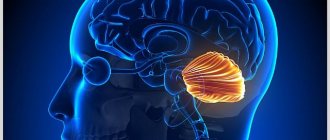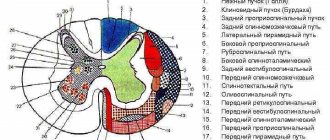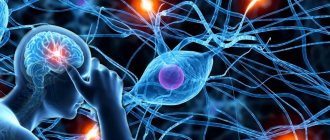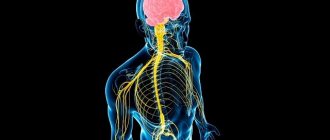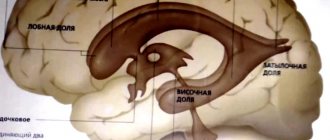The extrapyramidal system regulates muscle tone and is responsible for the speed of motor reactions. Thanks to the relationship with all parts of the nervous system, higher forms of nervous activity are available to humans.
When muscle tone is impaired, the activity of movements changes. In this case, extrapyramidal disorders are diagnosed, which are accompanied by insufficient or excessive movements. The syndrome occurs as a result of the death of brain cells or taking antidepressants, lithium, or antipsychotics.
Characteristics and classification of violations
The concept of “extrapyramidal disorders” includes a number of pathological conditions that develop as a result of damage to the cellular structure of the basal ganglia. This usually occurs after prolonged use of antipsychotics. Drugs in this group provoke the development of nervous tics, parkinsonism, stereotypy, tremor, chorea and other diseases. Such disorders lead to limitation of motor activity and the appearance of involuntary impulses.
Neuroleptic disorders manifest themselves in hypokinetic disorders that limit mobility, and in hyperkinetic disorders - increased frequency of involuntary reflexes.
Hypokinetic manifestations (hypokinesia)
Such dysfunction is accompanied by a decrease in motor activity. This is expressed in akinesis, when the initiation of motor acts is disrupted, and in bradykinesia, when movements slow down. Painful conditions provoke muscle hypertonicity and muscle rigidity.
Hyperkinetic manifestations (hyperkinesis)
Such disorders are expressed by the following symptoms:
- tremor, when repeated muscle contractions cause rhythmic vibrations of the body;
- chorea, in which different parts of the body move irregularly;
- ballism, accompanied by more sweeping and sudden movements compared to chorea;
- dystonia, in which muscles contract over a long period, leading to twisting and unhealthy positioning of body parts;
- akathisia, when a person cannot stay in one place, he wants to fuss, move, walk;
- myoclonus, in which the limbs twitch irregularly and synchronously;
- tics, which manifest themselves in stereotypical irregular movements.
Disorders of this group can be reflex (myoclonus), spontaneous (ballism, chorea), actional (dystonia, dyskinesia, tremor), specific (spasms when playing the piano, when embroidering).
Based on the severity of the motor act, hyperkinetic disorders are classified into rhythmic, when antagonist and agonist muscles periodically contract, tonic, when muscles twitch simultaneously, and fast clonic.
According to localization, hyperkinesis is differentiated into segmental, multifocal, focal, generalized.
symptoms of damage to the extrapyramidal system
Category: Neurological Nursing/Clinical manifestations of major neurological syndromesSymptoms of striopallidal lesions
Damage to the substantia nigra manifests itself as parkinsonian or akinetic-rigid syndrome
.
It includes: extrapyramidal rigidity
- increased tone of the flexors and extensors (“waxy flexibility”);
bradykinesia
- slowness, pallor of movements or
akinesia
- their absence;
tremor
- trembling of the hands, head, lower jaw; inertia; lack of friendly movements; mincing gait, monotonous, quiet speech.
Damage to the striatum is characterized by a hypotonic-hyperkinetic syndrome, including muscle hypotonia and various hyperkinesis - violent movements that cannot be controlled (unlike hyperkinesis, simply violent movements can be consciously inhibited).
The most common of them are the following:
- chorea
- fast, erratic movements, similar to deliberate antics, dancing; - tic
- short-term monotonous clonic twitching of individual muscle groups, most often the face; - facial hemispasm
- attacks of convulsive twitching of half the facial muscles; - myoclonus
- rapid, lightning-fast contractions of individual muscle groups; - athetosis
- slow, worm-like movements in the distal limbs; - ballism
- rapid rotational throwing movements in the limbs; - torsion dystonia
- rotational, corkscrew-like movements of the axial muscles of the trunk.
Symptoms of cerebellar damage
When the cerebellum is damaged, the functions of balance and coordination are affected, which is manifested by the following symptoms:
- nystagmus
- rhythmic twitching of the eyeballs, often when looking to the side; - scanned speech
- jerky speech with emphasis at certain intervals; - intention tremor
- tremor when performing precise movements; - miss
- missing when performing a targeted movement; - adiadochokinesis
- uncoordinated movements of the hands when they rotate in an extended position (on the affected side the hand lags behind); - static ataxia
- a violation of statics, which is manifested by instability in the Romberg test (vertical posture with arms extended forward); - ataxic (drunk) gait
- shaky, uncertain with arms wide apart; - dysmetria
- impaired range of motion; - muscle hypotonia
- decreased muscle tone; - dizziness
.
See clinical manifestations of major neurological syndromes
Saenko I. A.
Sources:
- Bortnikova S. M., Zubakhina T. V. Nervous and mental illnesses. Series 'Medicine for you'. Rostov n/d: Phoenix, 2000.
- Nurse's Handbook for Care/N. I. Belova, B. A. Berenbein, D. A. Velikoretsky and others; Ed. N. R. Paleeva. - M.: Medicine, 1989.
- Martynov Yu. S. Neurology: Textbook. ed. 4th, rev. and additional - M.: RUDN, 2009.
The first symptoms of the disorder
Initially, signs of extrapyramidal syndrome are expressed in aggressiveness and excessive irritability. Twitching of the limbs and facial muscles gradually develops. The primary manifestations of pyramidal system dysfunctions are separate diseases. Such pathologies are associated with atrophy of brain cells and the destruction of neurons.
Such diseases include parkinsonism, when tremors, excessive salivation, and a frozen facial expression appear. As it develops, dementia forms and speech skills are impaired. Disorders characterized by pathomorphological symptoms are distinguished: tremor, dystonia. The patient's limbs twitch, the muscles of the neck and head spasm.
Treatment recommendations
Treatment of extrapyramidal syndrome should be aimed at the disease that caused the pathological changes. Although in most cases the best effect is achieved with symptomatic therapy.
Drugs
The following groups of drugs are used:
- Neuroleptics (Haloperidol, Triftazin).
- Benzodiazepines (typical and atypical, Lorazepam, Diazepam).
- Beta-blockers (“Propranolol”, “Timolol”).
- Relieving muscle spasms (muscle relaxants Mydocalm, Sirdalud, Baclofen).
- Anticholinergics (“Atropine”, “Platifillin”).
- Removes free radicals (antioxidants: vitamin C, E, alpha-lipoic acid).
- Protecting nerve cells (neuroprotectors: Cerebrolysin, Piracetam).
- Means to strengthen the body.
Drugs are prescribed individually for each patient depending on the diagnosed syndrome. During treatment, the use of antipsychotics is adjusted, when taken, neuroleptic syndrome develops. In some cases, it is necessary to reduce the daily dose of drugs, if you cannot do without them, in others - completely eliminate them.
Other methods
During the rehabilitation period, physiotherapeutic procedures are used, including the following:
- electrophoresis;
- electrostatic field;
- ultra-high frequency therapy;
- light therapy;
- heat mud therapy;
- massage;
- physical therapy;
- reflexology;
- classes with a speech therapist and psychotherapist.
Folk remedies
Any type of extrapyramidal syndrome cannot be treated at home. The patient's restless, agitated state can be stabilized with soothing herbal decoctions.
Use the following recipes:
- Finely chop the valerian root. Pour boiling water (a glass) over a tablespoon and leave overnight. Use a thermos. Drink a tablespoon several times a day. In case of increased excitability, drink the resulting decoction in three doses of a third of a glass.
- Place a large spoonful of peppermint leaves in a container, add boiling water (a glass), simmer for 10 minutes, leave to cool. Drink half a glass of the strained liquid in the morning and before bed.
- Melissa officinalis is poured with a glass of boiling water (1:1) and infused. Drink the decoction in any quantity, as it has no contraindications. You can add it to tea.
If the patient has problems falling asleep or the quality of sleep is disturbed, use decoctions that act as a sleeping pill:
- Grind the root part of the celery. Pour a heaping tablespoon with a liter of cold water, which is boiled and cooled in advance. Leave for 8 hours. Drink a teaspoon three times a day. The infused liquid increases the duration of sleep.
- Finely grind the hawthorn fruits. Throw 2 large spoons of fruit into 1.5 cups of boiling water. Leave to cool. Drink the infusion in three doses half an hour before meals. Removes insomnia.
- Pour a glass of boiling water over hop cones (10 pieces) and boil for 10 minutes. Leave until warm. Drink before bed. Prepare a new infusion every day.
Description and treatment of individual forms of disorders
The concept of “extrapyramidal syndrome” unites a group of diseases, the symptoms and treatment of which depend on the location and degree of damage.
Parkinson's disease
The disease belongs to the category of degenerative pathologies of the central nervous system. The disease is caused by the destruction of neurons and some parts of the extrapyramidal system. In medical practice, the primary form of Parkinson's disease and the secondary form of Parkinson's disease - the syndrome of the same name - are differentiated separately. The primary form is caused by a genetic factor. Secondary syndrome is a sign of damage to the nervous system.
Necessary diagnostics
Identification of hyperkinetic extrapyramidal syndromes begins with observation of the patient, as a result of which the doctor compiles a list of movement disorders, determines changes in gait, writing, speech, and maintaining posture.
In recognizing extrapyramidal syndromes, it is important to create a picture of movements, which consists of the following elements:
- symmetry of movements;
- familiarity of the actions performed;
- speed and scope;
- connection with movements and poses of an arbitrary nature.
The next step is to find out the disease that caused the hyperkinetic syndrome. Determination of accompanying signs and factors that reduce or increase the manifestation of pathology. It is necessary to take into account the characteristics of the development of the disease.
Next comes numerous laboratory tests, which include:
- urine and blood tests for toxins;
- determination of the level of copper-containing protein in blood serum (ceruloplasmin), lactate, pyruvate;
- hormone levels;
- presence of antibodies;
- cerebrospinal fluid examination.
Instrumental diagnostics includes numerous methods to clarify the situation:
- ophthalmologist examination;
- genetic testing;
- electrophysiological;
- neuropsychological tests;
- excision of pieces of muscle, skin, nerve, brain tissue (biopsy).
2. Causes of the disease
The cause of these disorders is associated with damage to the extrapyramidal system of the brain and neurotransmitter imbalance. The extrapyramidal part of the brain ensures control of posture, smoothness of movements, and their compliance with the intended action. Accuracy, speed and coordination of different muscle groups are also controlled by this system.
Quite often, extrapyramidal disorders occur as a side effect of taking antipsychotic drugs.
. Drug-induced extrapyramidal disorders can also be observed when taking antidepressants, calcium antagonists, antiarrhythmic drugs and drugs prescribed for Parkinson's disease. Side effects of these drugs can occur in the first days of treatment or as a consequence of prolonged regular use (respectively, “early” and “late” drug disorders). Late extrapyramidal disorders can develop even after discontinuation of the drug and be irreversible. This risk must be taken into account when including these drugs in a therapeutic regimen.
Extrapyramidal disorders significantly reduce the quality of life of patients, severely limiting social activity. The psychological status is characterized by anxiety, feelings of inferiority, cognitive impairment, isolation, loss of interest in the outside world and serious feelings of loneliness.
Visit our Neurology page

